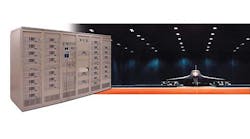Advanced Pulse Generator Uses DDS Technology to Increase Precision
While the principles of direct-digital-synthesizer (DDS) technology were formulated in the late 1960s (see “Generate Digital Chirp Signals With DDS” on Microwaves & RF), it has continually gained traction. For example, Northrop Grumman recently completed performance testing on an Advanced Pulse Generator (APG) as part of an upgrade to the Combat Electromagnetic Environment Simulator (CEESIM), which is used to test and validate the performance of electronic-warfare (EW) equipment. The updated APG utilizes high-speed DDS technology to generate RF waveforms for a variety of scenarios.
The APG is specifically designed with open-architecture modularity for optimal flexibility and for use with warning and jamming systems, radar-warning receivers, and IR/ultraviolet missile approach sensors. DDS technology further optimizes the system with its digitally based operations. According to the article “Ask the Application Engineer-33: All About Direct Digital Synthesis” by Eva Murphy and Colm Slattery of Analog Devices, DDS produces an analog waveform by generating a time-varying signal in digital form, then completing a digital-to-analog conversion. This allows for fast switching between output frequencies, finer frequency resolution, and functionality over a broad spectrum of frequencies.
DDS also can enable higher modulation sample rates, wider bandwidth intrapulse modulation, and reduced calibration time. This serves to minimize the RF part count, which can help reduce overall system cost while increasing reliability. Single-chip IC devices, for instance, can leverage DDS to generate waveforms simply and with high resolution and accuracy. Because of these capabilities, Murphy and Slattery go on to say that the DDS technique has gained rapid acceptance—especially compared to other methods of frequency generation, such as phase-locked-loop (PLL) -based techniques and the dynamic programming of digital-to-analog-converter (DAC) outputs.
The CEESIM is an advanced simulator that generates complex, dynamic electromagnetic environments to simulate wartime conditions. It provides angle-of-arrival radio-frequency simulation techniques including amplitude and time difference of arrival. Included is high-fidelity intrapulse modulation (HFIM) capability as well as communication, navigation, and identification (CNI) signal environments. They can simulate a variety of complex modulations on pulse characteristics.
